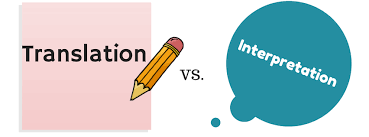Communication across different languages from one source to another end is accomplished by interpretation and translation. Both perform the same task but with a slight difference. Translation renders text or deciphers it from one language into another, preserving its meaning, whereas Interpretation describes the meaning of words spoken from one language into another.
What differs in Interpretation and Translation?
The oral form of translation is interpreting. It enables face-to-face communication in a meeting, conference, or over the phone. This can be known as real-time translation. In this, the interpreter listens to the contents of the speaker and paraphrases the meaning into the target language. An interpreter uses the tools of the target language and explains the spoken contents to other people.
An interpreter should actively translate on the spot in both directions without any reference materials. The work of an interpreter is to convey the meaning by keeping context intact. This needs expertise in a particular subject, knowledge of various cultures, and experience in this profession.
Translation deciphers text from one language to another, preserving its meaning. This is in written form. A translator must capture the style, content, and form of the text, and precisely render it into the required language. This is a time taking process because a translator has to read the content, decipher its meaning and write the same into the target language. Once written, the content needs proofreading to ensure that style, original meaning, and form are the same as the source content. The translator needs to widen understanding by going through consultation techniques and research. The product should be eloquently written, error-free, and polished.
Interpretation is quick to process and gives no time for a second chance. On-the-spot rendering of meaning is required for both i.e., consecutive and simultaneous interpreting modes. In the case of simultaneous interpreting, an interpreter needs to interpret at the same pace as a speaker. In this, the interpreter listens to the source language and speaks at the same time in the target language.

The interpreter listens to the speaker till the end and then interprets the content said before in consecutive interpreting. In this case, the interpreter takes written or mental notes and then renders the message in another language.
Both these professions need language skills that are in demand, especially in the field of law, medicine and business. Interpreters, as well as translators, are trained well so they can meet the professional code of ethics, i.e., they are dedicated to conveying the meaning accurately, faithfully, and impartially.
Do all languages have a translation-to-interpretation correlation?
Not all languages have a direct correlation in this regard. Some spoken or verbal languages have no written form such as Piraha, American Sign Language, and indigenous American languages. Some people refer to Chinese as a written and spoken language however, in China, there are approximately 250 spoken dialects that are considered as one written language i.e., Chinese Simplified and Chinese Traditional is used as a written language in Taiwan.
Share your views by writing valuable comments and do share the article.

